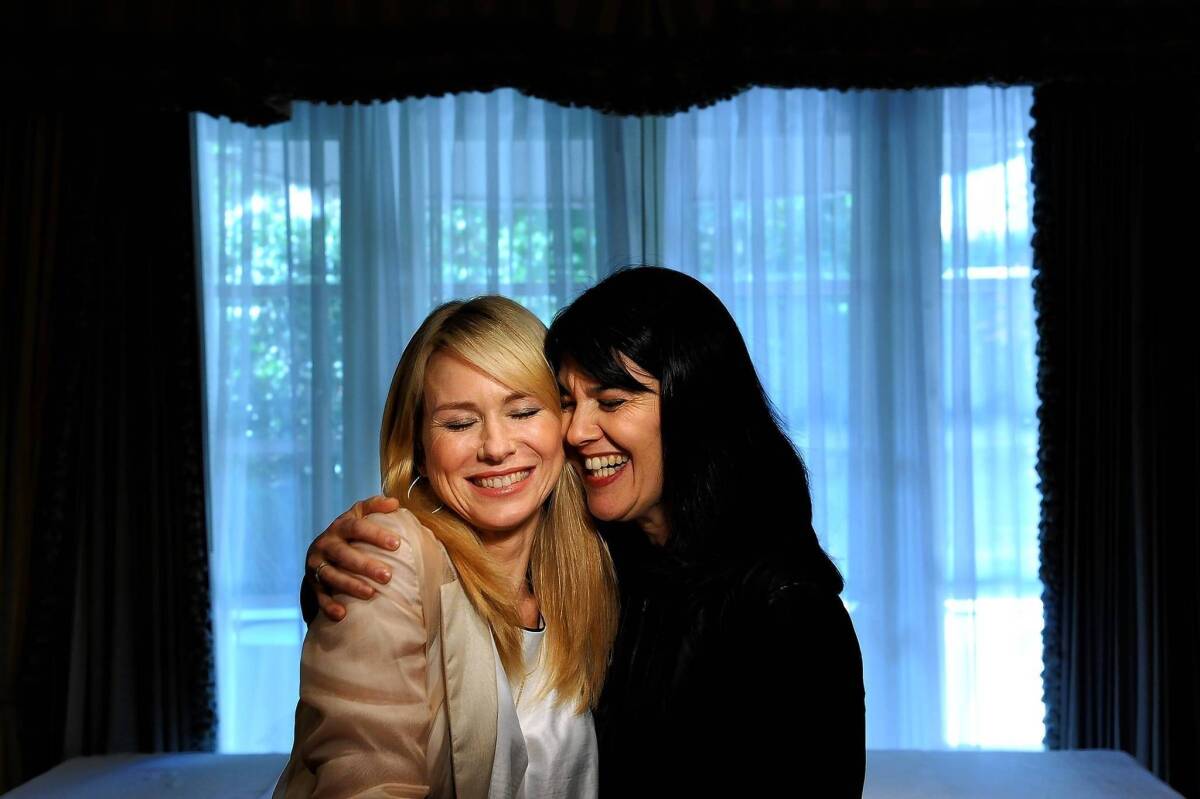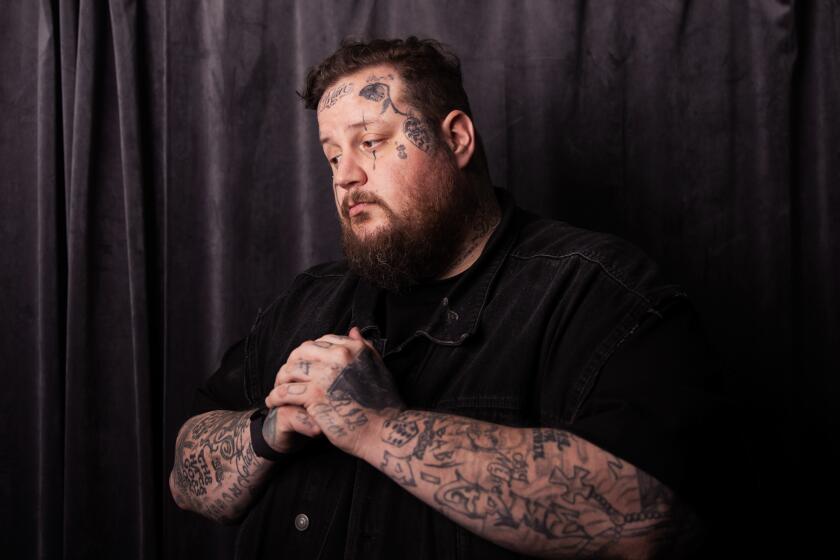A family’s ‘Impossible’ journey of healing

- Share via
Maria Belón wasn’t proud of her dumb luck. It had been nearly three years since the Indian Ocean tsunami roared into her family’s Christmas vacation in Thailand, killing 230,000 people but somehow sparing her, her husband and her three sons. The family had since returned to Madrid, resumed their routines, but she carried on her shoulders the pain and suffering of surviving something that took so many others’ lives. Lost in a quiet grief, unable to enjoy simple pleasures, she wasn’t eager to share her story.
One day, she was at home listening to the radio when Luz Casal came on the air to promote her new album. Spontaneously, Belón called in to thank the singer for “Un nuevo día brillará,” a song about new beginnings that Belón often sang during her arduous recovery. After that five-minute chat, the radio station persuaded her to come back on air for a program commemorating the 2004 disaster: For the first time, Belón poured out the harrowing tale of how the wave split her family apart and how they were miraculously reunited.
“I always felt nobody would be interested [in our story]. I never felt it was anything special,” Belón, 47, recalled recently in Los Angeles. “But from that moment we got feedback from people saying how touched they were. I thought: It does not matter what I feel about it but what happens when people hear it.”
PHOTOS: Hollywood backlot moments
Among the things that happened was a moment of cinematic serendipity: Movie producer Belén Atienza was driving on a highway in Barcelona when the program aired. She pulled over to listen, then abandoned her Christmas shopping for the day.
“I was obsessed with this mother that was in this situation where she couldn’t afford to die,” said Atienza. “I was a recent mother at the time and I was thinking, ‘What would I do? If I die, he would be alone.’ That’s how Maria felt when she spots the head of Lucas out of the water. She has to live.”
As a result of that day, the two forged a connection. It would take five years, but finally, they have brought the family’s story to the screen: “The Impossible,” starring Naomi Watts and Ewan McGregor, arrives in U.S. theaters Dec. 21.
Directed by “The Orphanage” helmer Juan Antonio Bayona, the movie has been met with early critical praise for its vivid, realistic visuals and emotional performances, and it became a blockbuster in Spain this fall. Watts is nominated for a SAG Award and a Golden Globe for playing Maria, a role that’s light on dialogue but full of feeling — and required her to spend hours being tossed around in a giant water tank and days trapped in a hospital bed.
Throughout the process, Belón wrote the filmmakers letters — lyrical pieces of prose, filled with vivid imagery. One, “Delirium,” conveyed her fragile state in the hospital when she was losing pints of blood and facing death.
“[The doctors] cut a piece of leg. I felt the tug. Can they throw it to the ocean. He is hungry. Very hungry. That’s why he bit all of us…”
For Belón, making the film was more than just a glamorous silver lining to a traumatic event: It was a cathartic experience that aided in her personal healing.
‘Big responsibility’
Atienza, Bayona and screenwriter Sergio G. Sanchez contacted Belón after her radio appearance.
PHOTOS: Celebrity portraits by The Times
“When we first met, I had two objectives,” said Belón. “One was trying to scare them and two was to look in their eyes and see if they were the ones who really wanted to swallow this big responsibility.”
Her family had traveled to Khao Lak, Thailand, in 2004 for their Christmas holiday; at the time, they were living in Japan because her husband, Enrique Alvarez, had a job there with Gillette. The tsunami hit the resort on the third day of their vacation.
Caught up in a wave, debris pounded Belón’s body, breaking her nose, tearing up her leg and causing bleeding in the kidneys, bladder and intestines. Belón found her oldest son, Lucas, in the water soon after the tsunami spit her out of the back of the hotel. She fought for her life in the Takua Pa hospital in southern Thailand, where she had emergency surgery. She and Lucas found Alvarez and the two younger boys the next day. She was airlifted out of the country on Dec. 29 and recuperated for four months in a Singapore hospital.
“I told them the whole story. One sitting. Five hours. Just one take. I was always looking in their eyes, and their eyes were full of life,” said Belón. “Full of tears. Full of life. Especially Bayona. He was breathing heavy.”
But that five-hour session was hardly the whole story; in fact, it was just the beginning. Belón decided she trusted the filmmakers and spent the next two years working with them on the script. It took another three years to make the movie.
In one letter, she described her mental state as she was reunited with her boys.
“They say my name softly. Yell it louder. I’m already walking towards the tunnel. .... ‘Mama, mama, wake up. Did you get on the same wave as I did?’ Simon is covered in mud. Tomas with his chubby cheeks and tear-streaked face is at his side. He has scratches and blood. He is very sad and very serious. ‘Ma, aren’t you happy to see us?’”
Belón is someone who lives in the clouds. Huge swells of love and sadness pool just behind her eyes. She guesses she has always been like that but facing death made it all the more intense.
“It’s like when you see a snake and it goes into the forest to shed its skin,” she said. “When it comes back it’s the same, but my skin is over there. I have a new skin. I’m myself, but my whole is something new.”
Twist of fate
Belón’s family was on board with the project, though her husband, nicknamed Quique, was the most cautious, not understanding why their story merited a film. So Belón served as her family’s liaison to the filmmakers — sharing drafts as they created the screenplay.
Her primary concern was ensuring that her family not be portrayed as heroes. They survived through luck only, she believes, standing in the right place when the wave hit.
PHOTOS: Hollywood backlot moments
She articulates the idea of fate in a letter titled “Daniel’s Mom,” written to the deceased mother of a boy she and Lucas rescued in the aftermath of the wave.
“It wasn’t your fault you died nor my fault I survived, it was fate. But fate has a sharp edge, it leaves wounds and buries scars. Fate isn’t always fair and that hurts. The pain is pain, but not guilt....That pain is like an invisible stone in my shoe, making it impossible to forget with every step, I’ll never get rid of it. The best I can do is to adapt to its presence.
That message resonated with the filmmakers.
“One of the things this story taught us is you don’t get to decide when you die and when you live,” said Sanchez. “This story has to be about loss. There are lots of people who lost lots of family members, who were not as lucky as Maria and her family. We had to be very careful to not do a version of the story where they can be offended.”
Added Bayona: “Survival was a question of fate. The position of every character, 2 meters to the right, 2 meters to the left, defined their destiny.”
Bayona decided to shoot in Thailand — at the Orchid Beach resort where the family stayed and the hospital where Belón and Lucas were reunited with their family.
The family embraced the idea. They had been invited back to Thailand a year after the tsunami, but Belón was still recovering and couldn’t fly. Six years later, they had the chance to find some closure with the land.
“We had to go back with different feelings than how we left,” said Belón. “We left feeling pain, shock. We needed to go back to that land, that place and say sorry for the moment we spent together.”
In December 2010, the family joined up with the production in Thailand. Each member of the family helped their actor counterpart to get the wave scene right — to place them in their exact spots when the tsunami hit.
“I could almost feel all the souls there. It was raining and raining and raining during the whole shoot. And it shouldn’t be raining,” said Belón. “It was the dry season. Bayona would say, ‘Maria, what is going on?’ I would say, ‘They need to cry. Let them.’”
Bayona showed the film to the family in August. Belón described the experience as a roller coaster — engaging in the intensity personally, then looking over at her children and husband, worried about how they were faring through the ride.
She finally broke down toward the end of the film. It was a scene in which McGregor, playing her husband, opens up a slip of paper — a calendar page. On one side, with the date Dec. 26, were the names Kathy and Gina, a fellow tsunami survivor’s wife and daughter he was trying to help find. On the other side was a note, jotted just before the wave hit by the two now missing: “We are at the beach.”
That moment, Belón said, overpowered her with grief for the hundreds of thousands of victims. Yet at the same time, she was confident the film honored their memories sufficiently and respectfully.
“I thought, ‘They will forgive me for any mistake I made,’” said Belón. This movie, she said, “It’s for the people who didn’t make it and for the people who are alive. I think of them every day — those that are suffering, those that miss people. I don’t miss people in my life. And missing people is the worst thing that can happen.”
Lucas, now 18, is studying medicine. Tomas, 17, is attending high school in Wales, and Simon, 13, is living with his parents in Madrid. Enrique is a general manager for Johnson & Johnson, and Maria is deciding what she’ll do next. She is lighter now. The wave changed her profoundly, but it didn’t break her. For that, she is thankful.
“I never believed in heaven or hell. I now pass freely through one and the other, in a moment. Hell is after the wave, it’s living full of dead people. Heaven is a divine gift. It’s being untouchable, it’s believing that none of this is real. My heaven has Simon’s smile, Tomas’ cheeks, Lucas’ hands and Quique’s eternal kiss.”
PHOTOS AND MORE
VIDEO: The making of ‘Argo,’ ‘Les Miz’ and more
The Envelope: Awards Insider
PHOTOS: NC-17 movies: Ratings explained
More to Read
The biggest entertainment stories
Get our big stories about Hollywood, film, television, music, arts, culture and more right in your inbox as soon as they publish.
You may occasionally receive promotional content from the Los Angeles Times.










